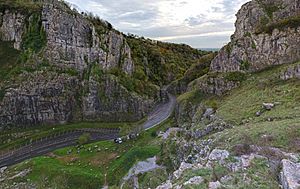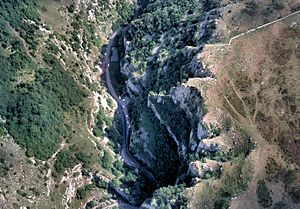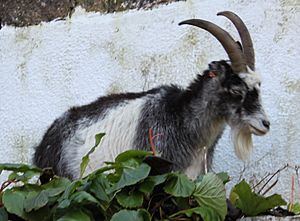Cheddar Gorge facts for kids
Cheddar Gorge is a huge limestone gorge located in the Mendip Hills in England. It's close to the village of Cheddar, Somerset. This amazing place is famous for its show caves. Here, in 1903, scientists found Britain's oldest complete human skeleton. This skeleton is known as Cheddar Man. He is thought to be about 9,000 years old! Even older human remains, from 12,000 to 13,000 years ago, have also been found.
The caves were formed by an underground river. They are filled with beautiful rock formations called stalactites and stalagmites. Cheddar Gorge is so special that it's part of a protected area. This area is called the Cheddar Complex.
Cheddar Gorge is a very popular place to visit. Many people come to see the caves and other attractions. In 2005, a TV show called Seven Natural Wonders featured the gorge. After this, people voted it the second greatest natural wonder in Britain. Only the Dan yr Ogof caves were more popular. About 500,000 visitors come to the gorge every year.
Contents
How Cheddar Gorge Was Formed
Cheddar Gorge is found on the southern edge of the Mendip Hills. It is very deep, reaching about 137 metres (449 feet) at its deepest point. The south side has a nearly straight-up cliff face. The north side has steep, grassy slopes. A road, the B3135, runs along the bottom of the gorge.
The rocks here are mostly Limestone from a time called the Carboniferous period. This limestone has fossils and small round grains called ooliths. Below this are older rocks like Old Red Sandstone.
The gorge was created by huge floods of meltwater. This happened during very cold periods over the last 1.2 million years. During the ice ages, ice and frozen mud blocked the caves. This made the limestone unable to absorb water. When the ice melted in summer, water had to flow on the surface. This powerful water carved out the gorge we see today.
During warmer times, water flowed underground through the porous limestone. This created the amazing caves. Today, much of the gorge looks dry. This is because the Cheddar Yeo river flows underground. It only appears in the lower part of the gorge, near Gough's Cave. The water from this river is used by Bristol Water. They have dams and ponds to supply the nearby Cheddar Reservoir.
The gorge can sometimes flood. In 1968, a big flood washed large rocks down the gorge. It damaged the cafe and the entrance to Gough's Cave. Cars were also washed away. In 2012, the road through the gorge was closed for weeks due to flood damage.
Who Owns Cheddar Gorge?
The south side of the gorge belongs to the Marquess of Bath's Longleat Estate. The cliffs on the north side are owned by The National Trust. Both owners work together to keep the area clear of overgrown plants and trees.
Most of the tourist activities are on the Longleat-owned south side. This includes the two main show caves and the visitor centre.
Animals and Plants of the Gorge
Cheddar Gorge is home to many interesting animals. You might spot dormice, yellow-necked mice, slowworms, and even adders. Rare butterflies like the large blue butterfly also live here.
Many wild birds fly around Cheddar Gorge. These include peregrine falcons, buzzards, kestrels, and ravens.
The plants in the gorge are also special. You can find plants that love chalky soil, like marjoram and wild thyme. A very rare flower called the Cheddar pink (Dianthus gratianopolitanus) only grows in the wild here. It used to be more common but people picked too many.
The gorge is also important for a type of tree called whitebeam. In 2009, scientists found three new types of whitebeam trees here! They named them the "Cheddar whitebeam," the "Twin Cliffs whitebeam," and the "Gough’s Rock whitebeam." The Cheddar whitebeam is unique to the gorge.
To help the plants grow, goats have been brought to the Longleat side of the gorge. They eat new tree growth and help rare plants like the Cheddar pink. The National Trust is also thinking about bringing sheep to their side for the same reason. There are already some wild Soay sheep in the gorge.
Exploring the Caves
There are two main caves open to visitors on the south side of the gorge. These are Gough's Cave and Cox's Cave. Both are named after the people who discovered them. These caves are known for their amazing rock formations. Some people even think they were used to age cheese long ago!
Gough's Cave was found in 1903. It goes about 400 metres (437 yards) into the rock. Inside, you'll see large rock chambers and formations. Cox's Cave, found in 1837, is smaller but has many detailed formations. In 2016, Cox's Cave became "Dreamhunters." This is a walk-through experience with special lights and videos.
The many caves in the gorge are home to colonies of Greater and Lesser horseshoe bats.
In 1999, a TV show called Time Team explored Cooper's Hole. They were looking for signs of early human activity from the Stone Age.
It's said that the caves behind Helm's Deep in J. R. R. Tolkien's The Two Towers were inspired by these caves.
Several caves in the gorge are protected as ancient monuments. This means they are important archaeological sites. These include Gough's Old Cave, Great Oone's Hole, Saye's Hole, Soldier's Hole, and Sun Hole.
Fun Things to Do
The Cliff Road (B3135) runs through the gorge. It's a popular and challenging climb for bicyclists. The road has a very steep section with a 16% gradient. This climb was even part of the 2011 Tour of Britain cycling race.
If you like rock climbing, there are many routes in Cheddar Gorge. There are about 590 climbing routes on the south side. These are usually open from October to March. The north side has about 380 climbing routes. These are generally open all year. Each climbing route has a name and is listed in a climbing guide. Some routes require climbers to place their own safety gear. Others have bolts already in place. Famous climber Chris Bonington was the first to climb the "Coronation Street" route in 1965.
The Cheddar Man Museum of Prehistory is a great place to learn more. It was inspired by the discovery of ancient humans like Cheddar Man. The museum has information about the caves and how they formed. You can see original flint tools and human remains found in the caves.
There's a clifftop walk that starts from Jacob's Ladder. You can walk along the top of the gorge and then back down to the road. This walk offers amazing views of the gorge. You can also try a caving experience inside Gough's Cave.
Jacob's Ladder is a path of 275 steps built up the side of the gorge. It's named after the Biblical story of a ladder to heaven. At the top, there's a watchtower. From here, you get a 360-degree view of the whole area and the village. During summer, you can take an open-top bus tour. And of course, Cheddar cheese is made in the lower part of the gorge!
Images for kids
See also
 In Spanish: Garganta de Cheddar para niños
In Spanish: Garganta de Cheddar para niños






